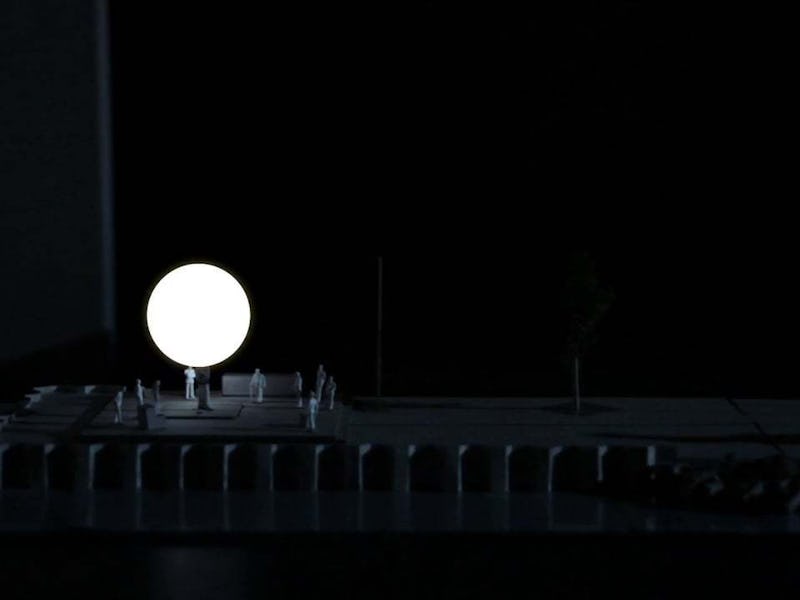
We earthlings have to seriously stretch our minds to grasp the expansiveness of outer space. Take the concept of light speed, for example: Light travels at a finite speed, 186,000 miles per second, fast enough to trace the Earth’s equator seven and a half times in one second. Space is generally measured in light years, which is to say, 5,865,696,000 equators at a time. It’s easy to talk about that distance, but grasping it intellectually is nearly impossible, given that humans have an innate and anatomic tendency to write down every figure bigger than 10. Our tendency is to say, “big” and pretty much leave it there.
“Your brain doesn’t suffice,” Dutch architect Caspar Noyons explains. “You have to experience it with the whole body.”
Noyons is trying to make that possible. His Speed of Light Project, which is slated to open in December as part of Amsterdam’s annual Light Festival (if it receives enough funding) is a scale model of the solar system that allows visitors to walk the distance between Earth and the sun at light speed. It will take a little more than 8 minutes depending on foot speed (humans are more variable than light).
The sun and Earth are separated by a long LED-lit path
The Speed of Light project consists of three main parts: Earth and the moon, the sun, and a line of LED lights stretching between the two, scaled to the distance between Earth and the sun. Since it takes sunlight approximately 8 minutes and 20 seconds to reach earth, the LED lights will guide visitors from Earth to the sun in that amount of time. By traveling at “light speed” between the Earth and the sun, visitors will further their inherently limited perceptions of the universe, and they’ll be doing it together.
Noyons’s idea of what the Speed of Light project will be has evolved and grown more complicated over the three years he’s been planning it. While its foundations are firmly rooted in science and architecture, it’s become clearer to Noyons that this is also an art installation with a revelatory spiritual component. “You can see it as a science installation, but you can also experience it as a metaphor for something, like some kind of cosmic journey,” Noyons said.
A rendering of what the sun in the Speed of Light project could look like
If science isn’t your thing, perhaps the idea that the Speed of Light journey is a return to our origin — the sun — will carry more impact for you. According to the big bang theory, Earth and the rest of the solar system were created by supernovas, or the explosions of massive stars. The Speed of Light project, in that respect, reverses this sequence of events, allowing us to travel — metaphorically at least — backwards in time.
“You’re like a photon without any mass just traveling through space, making the journey back to the sun,” Noyons says.
The experience doesn’t end once visitors reach the huge, glowing inflatable sun: Noyons and his team are planning to showcase several types of performances under the sun at the end of the walkway for the installation’s grand opening and once a week thereafter. Once you arrive at the sun, you may stumble upon a procession of light sculptures shaped like animals, live music, a scientific lecture about astronomy, or a DJ who does a closing party set, using the glowing sun as a massive stage. Also, at the beginning of the walkway, before the space gate, there will be a place to warm up on some gluhwein (mulled wine) as the installation is slated to go up at the peak of Amsterdam’s winter.
Noyon’s solar system is a friendly place.
If the sun gets funded, Noyons hopes it will look something like this
If all goes as planned, the Speed of Light project will open at the Amsterdam Light Festival along the IJ Promenade in the northern part of the city on December 21st, the winter solstice and shortest day of the year, signifying a departure from darkness and a return to sunlight. An audio guide will purposely isolate visitors during the eight-minute and 20-second walk, but they will recognize the company of their fellow people once they reach the sun and remove their headphones. The sun will be suspended about seven feet off the ground, which will allow visitors to stand under it and marvel as they gaze upward. Noyons calls on the image of Atlas holding up the world as an appropriate comparison, again emphasizing his desire to have the installation extend beyond scientific fact.
“I want to really make it a celebration.”